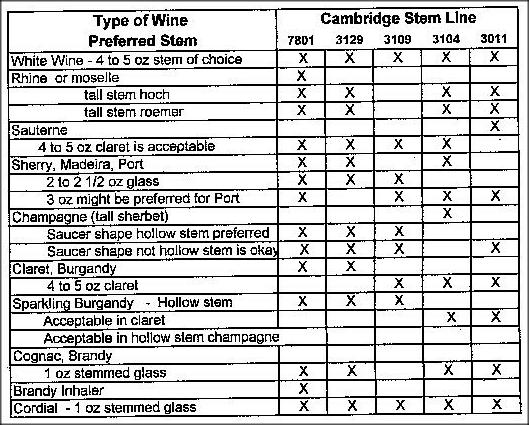"All Wine Should Be Served in Stemmed Glasses"
by Georgia G. Otten
Issue No. 327 - July 2000
My title is in quotation marks because I copied the line directly
from page 30 of a Cambridge Glass Company pamphlet, The Art of
Making Fine Glassware, third printing, 1941. This publication is a
mini-history of glassmaking in general and an introduction to Cambridge
glass spedfically. Although I have read it many times (topics
discussed: annealing, pressing and etching glass, among others) what
caught my eye this time was the helpful hints for the proper table
settings. I thought about some other brochures I had which include
various helpful hints; Reed and Barton Sterling "How to become a
successful hostess" written sometime in the 40s; one from the West
VIrginia Glass Company (Dec. 71) on how to pronounce those
hard-to-pronounce wines. I even looked at a book found in most homes,
"The Joy of Cooking." My primary interest became the use and placement
of various stems. The Cambridge pamphlet, again on page 30 gives a list
of various wine types and the acceptable stem for its service. It
states: The only glass served on the table at a formal dinner which may
 not match the waler goblet is the hock or roemer. All other glasses
must be of the same pattern as the water goblet.
not match the waler goblet is the hock or roemer. All other glasses
must be of the same pattern as the water goblet.
With all the listings of wines and specific glasses, I began to wonder which of the Cambridge stem lines could accommodate this "matching" obligation. By using the 1930-34 Catalog, Mark Nye's stemware book, and the 1940's catalog it did not take very long to find Cambridge stem line No. 7801. Take a look, it is a HUGE line. It appears to be the one line best able to handle the "match the water goblet" criteria.
Besides No. 7801, I used four other large lines: Nos. 3129, 3109 3104 and 3011. Then I constructed a chart which names the wines and stems as listed in the Cambridge pamphlet. Next step waa to mark the glasses which could be found in each of the five Cambridge stem lines. While I consider it improbable to have a formal dinner menu which would include all these wines at one meal, it is commendable that the Cambridge Glass Company made the stems available if the menu did indeed provide the courses!
Every time I look in a Cambridge book I believe I see something I have never seen before. There is always more to see and more to learn. I had not given much thought, or any thought, to the size of a stem line before. One just never knows what will trigger the look it up and find out mode. One disoovery leads to another. Imagine flndlng the 7801 line has a listing for a "192 ounce" brandy inhaler! That's what the catalog showed ... Okay ... party, party, party!
